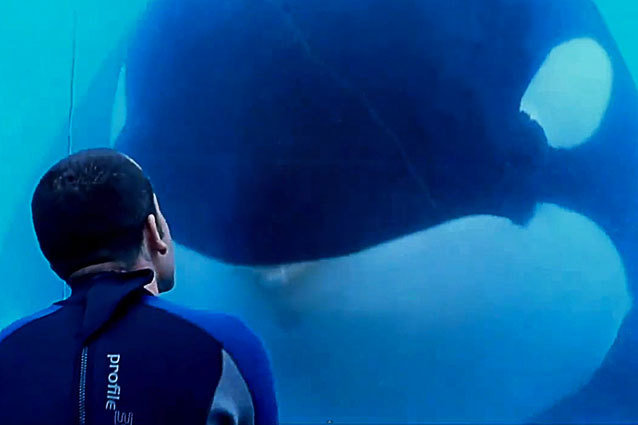Killer Whales: Is Captivity Okay?
 It’s no secret. Orcas – or killer whales as they’re widely known – are absolutely mesmerizing animals. Adults and children alike sit in awe as 8,000 to 12,000 pounds of power comes soaring out of the water with a smiling lady perched on the tip of its nose at Sea World every day. But do these huge creatures – as intelligent, beautiful, spiritual and majestic as they are – really belong in captivity, performing circus tricks for tourists? My personal opinion is no, they most certainly do not.
It’s no secret. Orcas – or killer whales as they’re widely known – are absolutely mesmerizing animals. Adults and children alike sit in awe as 8,000 to 12,000 pounds of power comes soaring out of the water with a smiling lady perched on the tip of its nose at Sea World every day. But do these huge creatures – as intelligent, beautiful, spiritual and majestic as they are – really belong in captivity, performing circus tricks for tourists? My personal opinion is no, they most certainly do not.
Many of you, cetacean lovers or not, may have heard of ‘Blackfish’ – a documentary directed by Gabriela Cowperthwaite that documents the life of Tilikum, a male killer whale held in captivity in Sea World, Orlando. The film, which premiered at the Sundance Film Festival on January 19, 2013, walks us through the life of orcas in captivity, from their initial capture to present day. As if seeing one young orca calf being taken from their family isn’t bad enough, we’re shown the life of one whale in particular, whose captive life has been far from easy.
The star of the documentary, a bull orca named Tilikium, is no stranger to the media. In February 1991, while Tilikum was living at Sealand of the Pacific, trainer Keltie Byrne slipped into a tank containing all three whales – including Tilikum – who lived in the park at that time. Witness reports state that, while she tried to push herself out of the tank, that a whale grabbed her and pulled her underwater. The orcas had never had a trainer in the water with them before, and thus tossed the trainer to each other’s mouths until she drowned. It is unclear what part Tilikum played in Keltie’s death, as witnesses could not be certain on which whale had initially pulled her under. However, this proved to be only the beginning of Tilikum’s string of incidents with trainers.
In the documentary ‘Blackfish’, we are shown footage of many trainer-whale encounters that could very easily have ended in death. From an eight thousand pound orca landing on a male trainer, to another being pulled by the foot to the depths of the tank in Shamu Stadium; these killer whales can easily snap. Whether their acts are playful or aggressive, these fierce sea mammals are not only too intelligent, but simply too big to be held in captivity. Not only that, but for a creature of this level of intelligence, being forced to perform tricks in exchange for dead fish seems simply degrading.
Sea World seems to have subsequently suffered since the release of the documentary, which publicly shamed the company’s overuse of the whales and their disregard for the whale’s natural needs. However, Fred Jacobs, a spokesman for SeaWorld, claims that the park’s drop in attendance has nothing to do with the release of ‘Blackfish’ – which Sea World accuse of being “dishonest”. Although The film also makes another compelling argument against Sea World – that the company ignored all danger signs of having trainers physically interact with the orcas, thus resulting in injuries and fatalities, such as the death of senior trainer Dawn Brancheau.
After being pulled by her arm from the platform on which she had been lying, Tilikum proceeded to mutilate and scalp Brancheau. The whale refused to let the trainer go, and even swallowed an arm. As if this extremely graphic and tragic death of an experienced trainer wasn’t enough to convince the general public that these creatures do not belong in captivity, Sea World appealed the decision of the courts to ban all waterworks (trainers swimming and performing with the whales in the water) with the orcas. Tilikum is also still forced to perform daily, despite his violent past, and many believe that he spends much of his time alone, away from the other orcas.
Since his capture in 1983, this orca, not unlike many other killer whales in his position, has been developing what some experts believe to be a psychosis, brought on by the trauma of being held in captivity. These social creatures form spectacularly strong family bonds, and their complex relationships with those in their pod rivals our own relationships with family and friends. Furthermore, each pod has a unique dialect, which shows off their true intelligence. It is not one bit surprising that when a calf is taken from its pod and forced to perform circus tricks, that it becomes stressed, upset and possibly even somewhat psychotic. Wild orcas have, thus far, never been recorded as aggressive toward humans – although that is not to say it isn’t a possibility – and females can live to be ninety years old, a lifespan far greater than a captive orca.
All in all – these powerful and gorgeous creatures were not made to live in swimming pools, breaching and diving on command for the pleasure of paying tourists. They were made to be exactly what they are – one of the oceans most feared predators and truly inspiring creatures to witness as they glide through the world's seas. But even more than that, orcas were always meant to be free.
Latest articles
-

Axolotls: A Different Kind of Pet
September 5th, 2015 at 10:52am
-

Save the Elephants
May 30th, 2014 at 05:09am
-

Can We Save the Blobfish or Is It Too Late?
April 12th, 2014 at 03:41am
-

Killer Whales: Is Captivity Okay?
September 8th, 2013 at 02:54am
-

The German Shepherd Dog
May 20th, 2013 at 11:32pm
